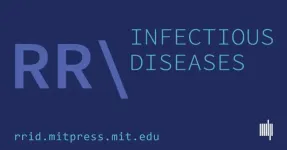(Press-News.org) While radio waves emitted by radio and television broadcasting and CB radio can disrupt the magnetic compass of migratory birds, those used in mobile communication networks do not because the frequencies are too high to affect their sense of orientation. This was the key finding of a new study published in the scientific journal Proceedings of the National Academy of Sciences (PNAS) by a team of researchers led by Professor Dr Henrik Mouritsen of the University of Oldenburg and Professor Dr Peter Hore of the University of Oxford (UK).
This finding also bolsters the researchers' theory that the magnetic compass sense in these birds is based on a quantum-mechanical effect (known as radical pair mechanism) located in their eyes. For this study, the team combined behavioural experiments with complex quantum-mechanical calculations on a supercomputer.
Mouritsen, Hore and colleagues had already demonstrated in 2014 that electrosmog (human-made electromagnetic noise) in the AM radio waveband, such as that generated by household electrical appliances, impairs migratory birds' ability to use the Earth's magnetic field for orientation (known as magnetoreception).
They posit that this weak electrosmog, which is harmless for humans, affects the complex quantum-physical processes in certain cells in the retinas of migratory birds which enable them to navigate with the help of the Earth's relatively weak magnetic field. But whether electrosmog also affects free-flying birds such as long-distance migratory birds, whose numbers have been declining for some time for unknown reasons, remains unclear.
A light-sensitive protein called cryptochrome
In the current study, the researchers took a closer look at the connection between the quantum-mechanical mechanism which they suspect forms the basis for the birds' magnetic sense and the disruption of this mechanism by radio waves. Their aim was to find further evidence of how the magnetic compass sense functions and thus provide a basis for further investigations into disruptive effects on the birds' migratory behaviour. The focus of their interest was the cut-off frequency above which the navigation of migratory birds remains unaffected, since determining this value allows conclusions to be drawn about the properties of the actual magnetic sensor in the birds. Their theory is that this sensor is a light-sensitive protein called cryptochrome 4 which possesses the necessary magnetic properties.
The scientists' initial theoretical prediction was that the cut-off frequency would lie somewhere between 120 and 220 megahertz in the Very High Frequency (VHF) range, so the team conducted behavioural experiments with Eurasian blackcaps using different frequency bands within this range. In a study published in 2022 the researchers had already demonstrated that radio waves of a frequency between 75 and 85 megahertz interfere with the magnetic compass sense of these small songbirds. These experiments showed that their magnetic compass stopped working when they were exposed to these radio frequencies, but worked properly without exposure. Blackcaps are long and medium-distance migrants that can cover long distances during their annual migration
High frequency radio waves did not affect the compass sense
In the current study, a team led by Mouritsen and Hore as well as the two lead authors – biologist Bo Leberecht and chemist Siu Ying Wong, both from the University of Oldenburg — conducted experiments with frequencies between 140 and 150 megahertz and between 235 and 245 megahertz. They found that the radio waves in both these frequency bands did not affect the birds' magnetic compass sense – which confirmed the scientists' theoretical predictions.
The researchers also performed model calculations in which they simulated the quantum-mechanical processes inside the cryptochrome protein. On the basis of these calculations they were able to narrow down the cut-off frequency even further, to 116 megahertz. According to the simulations, radio waves above this frequency would only have a weak effect on the birds' magnetic orientation. This prediction was borne out by the results of the experiments. "Our experiments, together with detailed theoretical predictions, provide strong evidence that the compass magnetoreceptor in migratory birds is based on a flavin-containing radical pair and not a completely different sort of receptor, for example one based on magnetic nanoparticles," Mouritsen explains.
Mobile communications networks do not impair the birds' magnetic sense
Gaining a better understanding of magnetoreception is important for improving the protection of migratory birds. It can provide insights on key questions, such as what kind of electromagnetic radiation drives birds off course and should therefore be avoided in areas like nature reserves where migratory birds stop to rest. Mouritsen underlines that whereas the radio waves used in radio and television broadcasting or CB radio play a decisive role in disrupting magnetoreception, mobile communications networks do not impair the birds' magnetic sense: "The frequencies used here are all above the relevant threshold."
This research is a result of the Collaborative Research Centre (CRC) Magnetoreception and navigation in vertebrates: from biophysics to brain and behaviour, of which Mouritsen is the spokesperson. The CRC's international team includes researchers from a wide range of disciplines including neurobiology, quantum physics, biochemistry, computer modelling and behavioural biology. In addition to the University of Oldenburg, the Institute of Avian Research "Vogelwarte Helgoland" (IfV) in Wilhelmshaven, the Freie Universität Berlin, the Ruhr University Bochum and the Weizmann Institute of Science in Rehovot (Israel) are also participating in the CRC. Three researchers from the University of Oxford (UK) are affiliated with the CRC as Mercator Fellows.
END
Which radio waves disrupt the magnetic sense in migratory birds?
Researchers narrow down frequency range
2023-08-28
ELSE PRESS RELEASES FROM THIS DATE:
CDI publishes paper showing dynamics of COVID-19’s pandemic peak
2023-08-28
The SARS-CoV-2 virus swept across the globe at the beginning of 2020, and one of the earliest and hardest-hit areas of the United States was New Jersey.
Hackensack Meridian Health, the state’s largest and most comprehensive health network, played a major role in virus detection and tracking of the virus’s evolution and dynamics, due to the expertise of the Hackensack Meridian Center for Discovery and Innovation (CDI), the network’s research institute.
Now the CDI experts ...
New MIT Press journal Rapid Reviews\Infectious Diseases will extend fight against disinformation to more infectious diseases and emerging pandemics
2023-08-28
The MIT Press and UC Berkeley School of Public Health proudly announce the launch of Rapid Reviews\Infectious Diseases (RR\ID). Building on the accomplishments of Rapid Reviews\COVID-19 (RR\C19), the Rapid Reviews editorial team is now setting their sights even higher.
“RR\C19 launched at a critical moment in global history and we are incredibly proud of the impact the journal has had so far,” said Stefano Bertozzi, editor-in-chief of RR\ID and Professor of Health Policy and Management at the UC Berkeley School of Public Health. “But when monkeypox started to spread in ...
Brain signals transformed into speech through implants and AI
2023-08-28
Researchers from Radboud University and the UMC Utrecht have succeeded in transforming brain signals into audible speech. By decoding signals from the brain through a combination of implants and AI, they were able to predict the words people wanted to say with an accuracy of 92 to 100%. Their findings are published in the Journal of Neural Engineering this month.
The research indicates a promising development in the field of Brain-Computer Interfaces, according to lead author Julia Berezutskaya, researcher ...
How plants pass down genetic memories
2023-08-28
When organisms pass their genes on to future generations, they include more than the code spelled out in DNA. Some also pass along chemical markers that instruct cells how to use that code. The passage of these markers to future generations is known as epigenetic inheritance. It’s particularly common in plants. So, significant findings here may have implications for agriculture, food supplies, and the environment.
Cold Spring Harbor Laboratory (CSHL) Professors and HHMI Investigators Rob Martienssen and Leemor Joshua-Tor have been researching how plants pass along the markers that ...
BU CTE Center publishes largest CTE case series ever in youth, high school and college athletes who died young
2023-08-28
EMBARGOED by JAMA Neurology until 11 a.m. EDT Aug. 28, 2023
Contact: Maria Ober, 617-224-8963, mpober@bu.edu
(Boston)— A new BU Chronic Traumatic Encephalopathy (CTE) Center study has found that, among a sample of 152 young athletes exposed to repetitive head impacts (RHI) who were under age 30 at the time of death, 41.4% (63) had neuropathological evidence of CTE, a degenerative brain disease caused by RHI. The study published in JAMA Neurology includes the first American woman athlete diagnosed with CTE, a 28-year-old collegiate soccer player whose identity remains private.
“This study clearly shows that the pathology of CTE starts early,” said corresponding ...
NIH study shows association between better neighborhood conditions and lower childhood asthma rates
2023-08-28
Living in a neighborhood with better access to resources such as high-quality housing, healthy food, parks and playgrounds, and clean air during the early stages of childhood was associated with lower asthma incidence in a new study from NIH’s Environmental influences on Child Health Outcomes (ECHO) Program.
Children born in high-opportunity neighborhoods had an asthma incidence rate of 23.3 cases per 1,000 children, while those born in very low and low-opportunity neighborhoods had rates of 35.3 per 1,000 ...
Scientists use quantum device to slow down simulated chemical reaction 100 billion times
2023-08-28
Scientists at the University of Sydney have, for the first time, used a quantum computer to engineer and directly observe a process critical in chemical reactions by slowing it down by a factor of 100 billion times.
Joint lead researcher and PhD student, Vanessa Olaya Agudelo, said: “It is by understanding these basic processes inside and between molecules that we can open up a new world of possibilities in materials science, drug design, or solar energy harvesting.
“It could also help improve ...
Assessment of hospital-onset SARS-CoV-2 infection rates and testing practices
2023-08-28
About The Study: In this study of hospitals reporting SARS-CoV-2 infections, there was an increase of hospital-onset SARS-CoV-2 infections when community-onset infections were higher, indicating a need for ongoing and enhanced surveillance and prevention efforts to reduce in-hospital transmission of SARS-CoV-2 infections, particularly when community-incidence of SARS-CoV-2 infections is high.
Authors: Kelly M. Hatfield, M.S.P.H., of the Centers for Disease Control and Prevention in Atlanta, is the ...
Trends in suicide rates among post-9/11 veterans with and without traumatic brain injury
2023-08-28
About The Study: In a large cohort of U.S. military veterans serving after 9/11, suicide rates increased more than 10-fold from 2006-2020, a significantly greater rate of change than in the U.S. adult population. Over the 15-year period, veterans with traumatic brain injury (TBI) had suicide rates 56% higher than veterans without TBI and three times higher than the U.S. adult population.
Authors: Jeffrey T. Howard, Ph.D., of the University of Texas at San Antonio, is the corresponding author.
To access the embargoed study: Visit our For The Media website at this link https://media.jamanetwork.com/
(doi:10.1001/jamaneurol.2023.2893)
Editor’s ...
Estimated lifetime gained with cancer screening tests
2023-08-28
About The Study: The findings of this systematic review and meta-analysis of 18 long-term randomized clinical trials involving 2.1 million individuals suggest that current evidence does not substantiate the claim that common cancer screening tests save lives by extending lifetime, except possibly for colorectal cancer screening with sigmoidoscopy.
Authors: Michael Bretthauer, M.D., Ph.D., of the University of Oslo in Oslo, Norway, is the corresponding author.
To access the embargoed study: Visit our For The Media website at this link https://media.jamanetwork.com/
(doi:10.1001/jamainternmed.2023.3798)
Editor’s ...
LAST 30 PRESS RELEASES:
Understanding sex-based differences and the role of bone morphogenetic protein signaling in Alzheimer’s disease
Breakthrough in thin-film electrolytes pushes solid oxide fuel cells forward
Clues from the past reveal the West Antarctic Ice Sheet’s vulnerability to warming
Collaborative study uncovers unknown causes of blindness
Inflammatory immune cells predict survival, relapse in multiple myeloma
New test shows which antibiotics actually work
Most Alzheimer’s cases linked to variants in a single gene
Finding the genome's blind spot
The secret room a giant virus creates inside its host amoeba
World’s vast plant knowledge not being fully exploited to tackle biodiversity and climate challenges, warn researchers
New study explains the link between long-term diabetes and vascular damage
Ocean temperatures reached another record high in 2025
Dynamically reconfigurable topological routing in nonlinear photonic systems
Crystallographic engineering enables fast low‑temperature ion transport of TiNb2O7 for cold‑region lithium‑ion batteries
Ultrafast sulfur redox dynamics enabled by a PPy@N‑TiO2 Z‑scheme heterojunction photoelectrode for photo‑assisted lithium–sulfur batteries
Optimized biochar use could cut China’s cropland nitrous oxide emissions by up to half
Neural progesterone receptors link ovulation and sexual receptivity in medaka
A new Japanese study investigates how tariff policies influence long-run economic growth
Mental trauma succeeds 1 in 7 dog related injuries, claims data suggest
Breastfeeding may lower mums’ later life depression/anxiety risks for up to 10 years after pregnancy
Study finds more than a quarter of adults worldwide could benefit from GLP-1 medications for weight loss
Hobbies don’t just improve personal lives, they can boost workplace creativity too
Study shows federal safety metric inappropriately penalizes hospitals for lifesaving stroke procedures
Improving sleep isn’t enough: researchers highlight daytime function as key to assessing insomnia treatments
Rice Brain Institute awards first seed grants to jump-start collaborative brain health research
Personalizing cancer treatments significantly improve outcome success
UW researchers analyzed which anthologized writers and books get checked out the most from Seattle Public Library
Study finds food waste compost less effective than potting mix alone
UCLA receives $7.3 million for wide-ranging cannabis research
Why this little-known birth control option deserves more attention
[Press-News.org] Which radio waves disrupt the magnetic sense in migratory birds?Researchers narrow down frequency range




